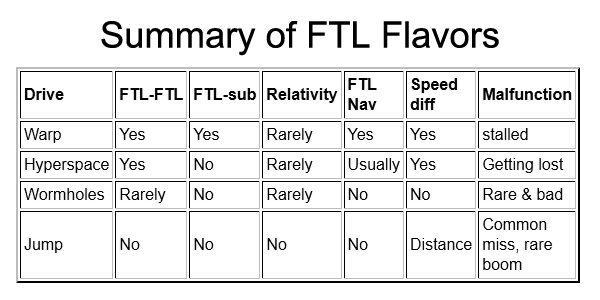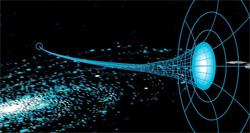This is the sixth and final installment of my series on the different flavors of FTL. We’ve warped through hyperspace and jumped through wormholes… or something like that. To clear it up, here’s a summary table showing how these various flavors stack up on the criteria I used:

Clearly, that’s a simplification of several simplifications, but in reducing the various drive features to simple yes/no pairs, it highlights a couple of things. First, not all of the options are represented. What if you took something like warp drive and changed the FTL-FTL box to no? What would that look like if FTL ships could no longer interact? Is it that they cannot see each other? Or maybe they only see each other long after they’ve passed? Maybe they have FTL drives but not FTL sensors?
For another example, what if we put a “yes” in the FTL-Navigation box for wormholes? Maybe instead of simple point-to-point tubes, we’re actually cruising through a complex network of junctions and connectors. Maybe our expected Sol-to-Rigel trip is merely the result of taking all the default options at every junction? What if we could alter course at key junction points and end up somewhere entirely different? What if that kind of exploration can only be done by trial and fatal error?
The second thing I notice with such a table reduction is that there are very different ways to expand these choices into the story mechanics of the drive system. Consider that wormholes and jump drives have almost identical table entries, i.e. Rarely or No across most of the table. Yet these two FTL systems have very different feels to their stories.
Similarly, even staying within a single system can give you FTL drives that end up looking quite different in the actual stories. Consider warp drive. We’re all familiar with how it works in Star Trek. We tear across the universe, warping space and manipulating subspace fields and so on. In my space opera universe of the Hudson Confederacy, ships are using tachyon drives, essentially throwing up ephemeral sails to catch the tachyon wind and yank them up to FTL speeds. The mechanism looks completely different, yet functionally, my tachyon sails are just another warp drive. But my navigators don’t worry about subspace interference. Instead, they worry about shifting winds and tachyon storms.
Furthermore, it’s also an over-simplification to think that a story must use only one flavor of FTL. Many combine them. For example, the Honor Harrington series by David Weber uses a mix of hyperspace and wormholes. That is, while most travel occurs via hyperspace, one planetary system hosts the intersection point of several long-distance wormholes, giving them a huge strategic advantage both for shipping and war. Similarly, some of the later Star Trek series (TNG, DS9, and Voyager) added rare wormholes on top of their trusty warp drive fleet.
So, did I skip a flavor? Probably. There’s a lot of SF out there. Some of those FTL systems may indeed be fundamentally different, but I suspect that a lot of them will boil down to being one of these four with different names and different hand-waving for the so-called science.
But the most important thing for all of them is to get your characters from here to there before they grow old and die. And once there, they can try to write a letter home, which brings up the matter of FTL communication, but that’s a subject for some future series of articles. With luck, I’ll get to that before we reach Sirius.
The whole series: Intro, Warp Drive, Hyperspace, Wormholes, Jumping, Summary

 This is the fourth in my series on various flavors of Faster Than Light (FTL) travel, and today I’m dropping into wormholes. The basic idea of a wormhole is that it’s a shortcut between two points. Usually they are fixed points, but there’s some variation on that. Sometimes they are done as predefined shortcuts through some alternate parallel space, and other times they are special tunnels through our own space.
This is the fourth in my series on various flavors of Faster Than Light (FTL) travel, and today I’m dropping into wormholes. The basic idea of a wormhole is that it’s a shortcut between two points. Usually they are fixed points, but there’s some variation on that. Sometimes they are done as predefined shortcuts through some alternate parallel space, and other times they are special tunnels through our own space. But one last bit on wormholes. Like the warp drive, these might be possible if not actually feasible. What we call a wormhole is remarkably similar to a prediction of General Relativity, known more properly as a Einstein-Rosen Bridge. However, since our best theoretical examples of such wormholes are tied up with black holes, this still has a long way to go to before we can turn it into the green-line express from Sol to Rigel.
But one last bit on wormholes. Like the warp drive, these might be possible if not actually feasible. What we call a wormhole is remarkably similar to a prediction of General Relativity, known more properly as a Einstein-Rosen Bridge. However, since our best theoretical examples of such wormholes are tied up with black holes, this still has a long way to go to before we can turn it into the green-line express from Sol to Rigel.